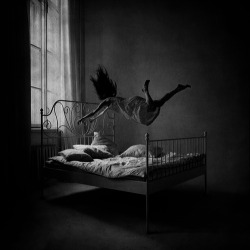The Mara is a female spirit like being from Scandinavian mythology.
One of the earliest mention and possibly the original origins of the tale comes from the Norse Ynglinga saga, a 13th century saga written by Snorri Sturlson, an Icelandic poet.
In the saga King Vanlandi Sveigoisson of Uppsala is killed by a mara which is conjured by the Finnish sorceress Huld, hired by the king’s abandoned wife.
.....
–Ynglinga Saga, Verse 16..
“Driva bribed the witch-
wife Huld, either that she should bewitch Vanlande to return to
Finland, or kill him. When this witch-work was going on Vanlande
was at Upsal, and a great desire came over him to go to Finland;
but his friends and counsellors advised him against it, and said
the witchcraft of the Finn people showed itself in this desire of
his to go there. He then became very drowsy, and laid himself
down to sleep; but when he had slept but a little while he cried
out, saying that the Mara was treading upon him. His men
hastened to him to help him; but when they took hold of his head
she trod on his legs, and when they laid hold of his legs she
pressed upon his head; and it was his death. The Swedes took his
body and burnt it at a river called Skytaa, where a standing
stone was raised over him.”
....
....... .
........
In Polish folklore the mara is described as a soul of a living person who leaves their body at night (astral projection) and are seen by others in the form of wisps of hair or moths.
In Czech lore there are stories of a “night-butterfly,” also thought to be linked to the mara legend.
In Russian folklore she's invisible but with the ability to also take the form of a woman with long hair. Other mentions of mara in Slavic folklore include descriptions of the her as a succubus-like creature that invades men’s dreams and lead them to their doom (Croatia) and as a spirit who enters through the keyhole and strangles you while you sleep (Serbia).
In Turkey, the mara is called the Karabasan which translates to “ominous-presser.”
,.....
In the Icelandic Vatnsdæla saga as a spirit connected to the fate of the person it is attached to and in the Eyrbyggja saga (also Icelandic in origin) where the sorceress Geirrid is said to assume the shape of a marlíðendr or “night-rider.”
In Germany there are records of charms and prayers to ward off the mara, such as the below:
Here I am lying down to sleep;
No night-mare shall plague me
until they have swum through all the waters
that flow upon the earth,
and counted all stars
that appear in the skies.
Thus help me God Father, Son, and Holy Ghost. Amen!..
,..... .
The legend of the mara is also connected to the legend of the old had or night hag, a story used in many cultures to explain sleep paralysis.
The first definition of sleep paralysis appears in Samuel Johnson’s Dictionary under the term “nightmare”:
Nightmare n.s. [night, and according to Temple, mara, a spirit that in the heathen mythology, was related to torment to suffocate sleepers.] A morbid oppression in the night, resembling the pressure of weight upon the chest.
Old Hag, Night Hag.
......
Other versions from around the world.
..
In Japan it is referred to as kanashibari, which translates as “to bind” or “to tie.”
In Mongolia sleep paralysis is called khar darakh, which translates to “to be pressed by the Black.”
Thai belief describes sleep paralysis as being caused by a ghost called Phi Am.
Newfoundland and parts of the southern United States where the hag leaves her body and sits on the chest of the victim.
In Arab cultures it is referred to as Ja-thoom which means “what sits heavily on something.” It is believed sleep paralysis can be prevented by reading the Throne verse of the Quran.
......
The origins of the name comes from the Nordic word for nightmare (the Norwegian word for nightmare is mareitt, the Icelandic name is martroo, and the Swedish word is mardrom). Mareitt and martroo roughly translate as “mare-ride”, referencing the original use of the term, while mardrom translates as “mare-dream.”
...
🎃 Happy Halloween 👻




No comments:
Post a Comment